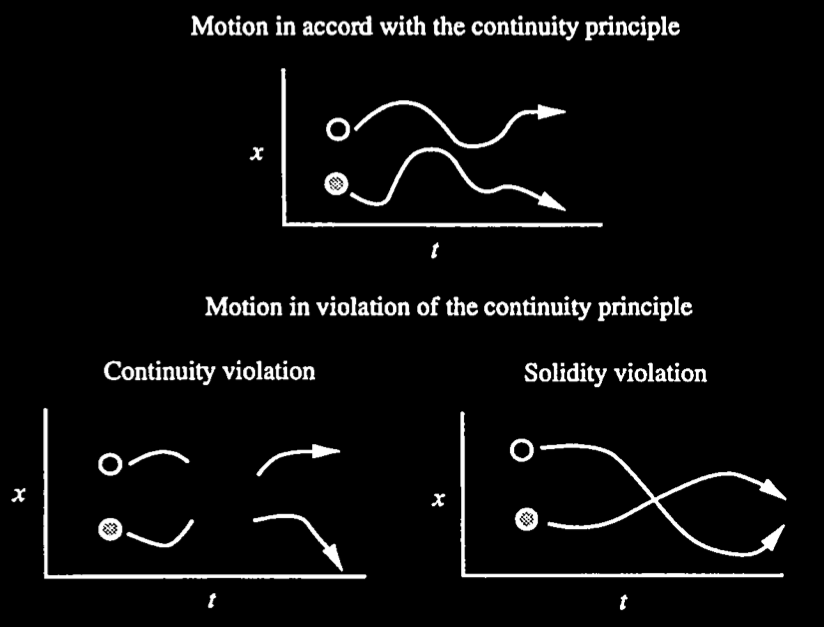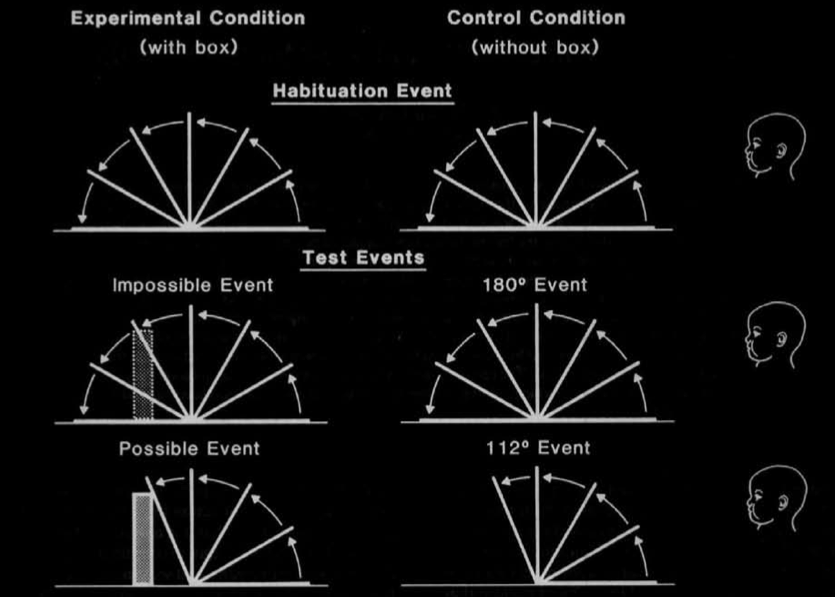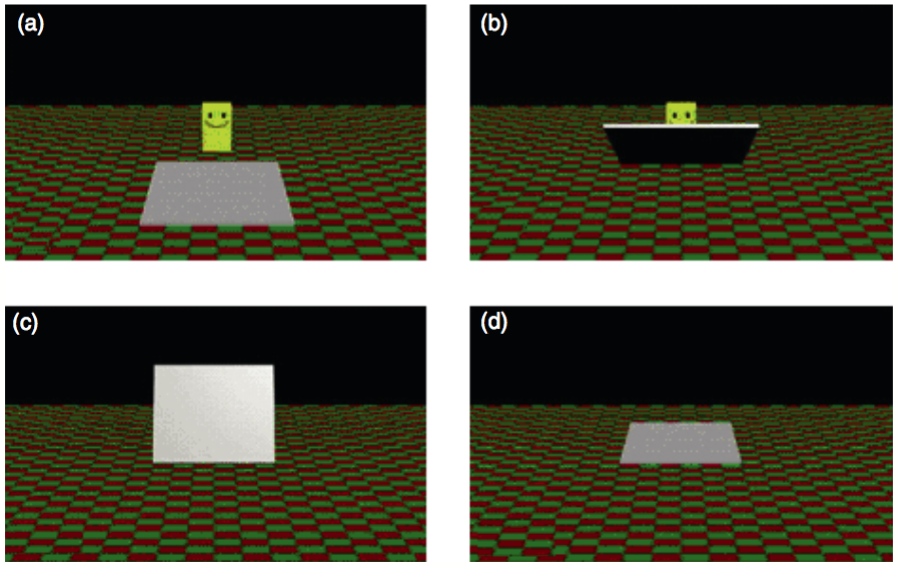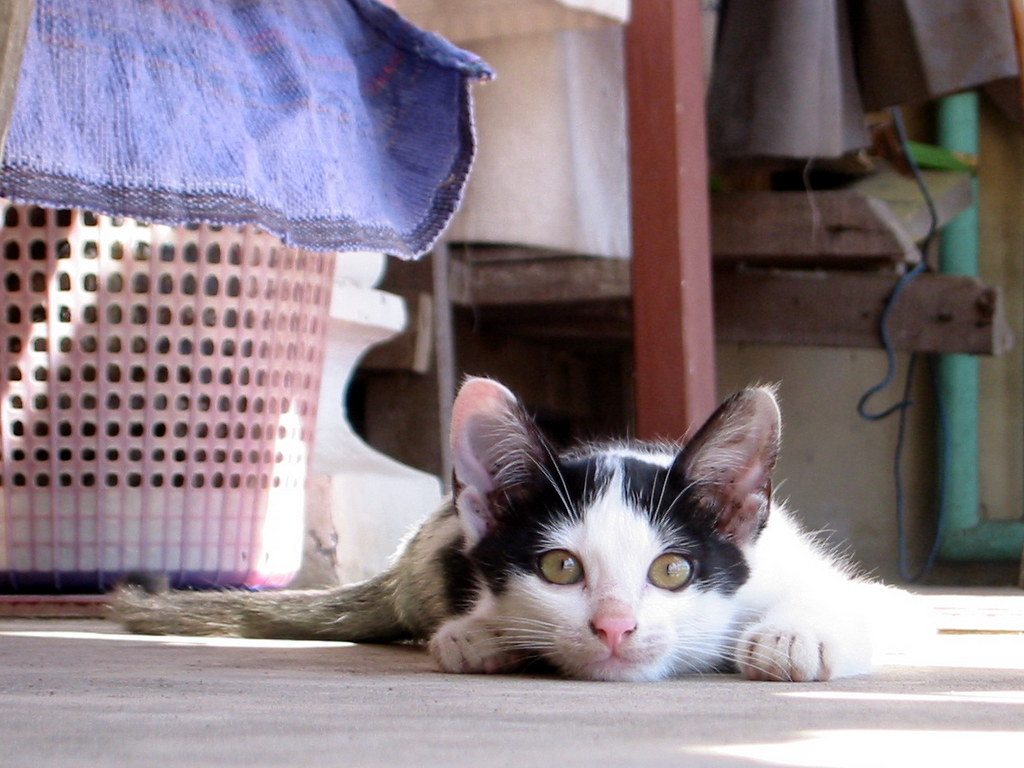Click here and press the right key for the next slide.
(This may not work on mobile or ipad. You can try using chrome or firefox, but even that may fail. Sorry.)
also ...
Press the left key to go backwards (or swipe right)
Press n to toggle whether notes are shown (or add '?notes' to the url before the #)
Press m or double tap to slide thumbnails (menu)
Press ? at any time to show the keyboard shortcuts
Permanence

Permanence
[email protected]

objects
have boundaries
persist through time
causally interact
knowledge of objects
involves
segmenting them
representing them as perstising
tracking their causal interactions
Object permanence:
the ability to know things about, or represent, objects you aren't currently perceiving.
‘young infants’ physical world, like adults’, includes both visible [perceived] and hidden objects’
(Wang et al 2004, p. 194)
principle of continuity---
an object traces exactly one connected path over space and time

Spelke et al (1995, figure 1)


Spelke et al (1995, figure 2)


Spelke et al (1995, figure 3)





Baillargeon et al (1987, figure 1)



source: Baillargeon et al (1987, figure 2)
fail?

Sirois & Jackson 2012, figure 3
So Baillargeon’s drawbridge study doesn’t demonstrate object permanence?

Sirois & Jackson 2012, figure 1


Wang et al (2004, figure 1)

Wang et al (2004, figure 2)
Control condition

Wang et al (2004, figure 1)
Experimental condition

Wang et al (2004, figure 1)
Control condition

Wang et al (2004, figure 1)

Wang et al (2004, figure 2)
4- and 5-month-olds can track briefly occluded objects
| scenario | method | source |
| 1 vs 2 objects | habituation | Spelke et al 1995 |
| one unperceived object constrains another’s movement | habituation | Baillargeon 1987 |
| where did I hide it? | violation-of-expectations | Wilcox et al 1996 |
| wide objects can’t disappear behind a narrow occluder | violation-of-expectations | Wang et al 2004 |
| when and where will it reappear? | anticipatory looking | Rosander et al 2004 |
Object permanence is found in nonhuman animals including
- monkeys (Santos et al 2006)\item monkeys (Santos et al., 2006)
- lemurs (Deppe et al 2009)\item lemurs (Deppe et al., 2009)
- crows (Hoffmann et al 2011)\item crows (Hoffmann et al., 2011)
- dogs and wolves (Fiset et al 2013)\item dogs and wolves (Fiset & Plourde, 2013)
- cats (Triana & Pasnak 1981)\item cats (Triana & Pasnak, 1981)
- chicks (Chiandetti et al 2011)\item chicks (Chiandetti & Vallortigara, 2011)
- dolphins (Jaakkola et al 2010)\item dolphins (Jaakkola et al., 2010)
- ...

‘The real difficulty is that there is no reward for the great majority of cats in retrieving an unmoving, silent, odor-free, covered-up object from which their attention has been distracted, and hence the cats will not show that they know where it is.’
(Triana & Pasnak 1981, p. 138)
principles of object perception
{
segmentation
permanence
... (?)
Three Questions
1. How do four-month-old infants model physical objects?
2. What is the relation between the model and the infants?
3. What is the relation between the model and the things modelled (physical objects)?
‘evidence that infants look reliably longer at the unexpected than at the expected event is taken to indicate that they
‘(1) possess the expectation under investigation;
‘(2) detect the violation in the unexpected event; and
‘(3) are surprised by this violation.’
‘The term surprise is used here simply as a short-hand descriptor, to denote a state of heightened attention or interest caused by an expectation violation.’
(Wang et al 2004, p. 168)
‘To make sense of such results [i.e. the results from violation-of-expectation tasks], we … must assume that infants, like older learners, formulate … hypotheses about physical events and revise and elaborate these hypotheses in light of additional input.’
(Aguiar and Baillargeon 2002: 329).
Crude Picture of the Mind
- epistemic
(knowledge states) - broadly motoric
(motor representations of outcomes and affordances) - broadly perceptual
(visual, tactual, ... representations; object indexes ...)